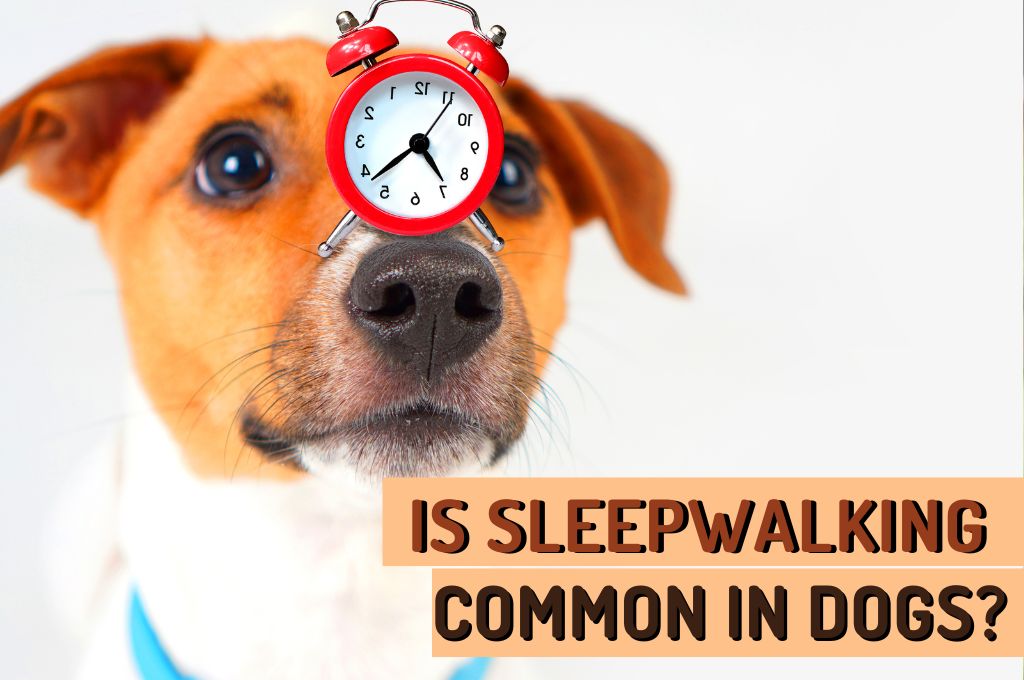Do you ever wonder if dogs can sleepwalk? It may sound like a peculiar behavior for our furry friends, but sleepwalking in dogs is indeed a possibility. In this article, we will explore the causes, symptoms, and treatment options for sleepwalking in dogs. Discover the fascinating world of canine sleep disorders and gain a deeper understanding of this peculiar phenomenon.
Causes
Genetics
Genetics can play a role in sleepwalking in dogs. Some breeds may be more predisposed to sleepwalking due to certain genetic factors. For example, certain lines of Border Collies have been found to have a higher incidence of sleepwalking compared to other breeds. While the exact genetic mechanisms behind sleepwalking are not yet fully understood, it is believed that certain genes may contribute to the development of this behavior in dogs.
Medical conditions
Certain medical conditions can also contribute to sleepwalking in dogs. Neurological disorders, such as epilepsy or brain tumors, can disrupt normal sleep patterns and lead to sleepwalking episodes. Other conditions, such as sleep apnea or restless leg syndrome, can also cause disturbances in sleep and increase the likelihood of sleepwalking. It is important to consult with a veterinarian to properly diagnose any underlying medical conditions that may be contributing to sleepwalking in your dog.
Stress and anxiety
Stress and anxiety can manifest in various ways in dogs, and sleepwalking can be one of the symptoms. Dogs experiencing high levels of stress or anxiety may exhibit sleepwalking behavior as a coping mechanism or a response to their emotional state. This can be particularly common in dogs who have experienced trauma or have a history of separation anxiety. Providing a calm and secure environment for your dog and addressing any underlying stressors or anxiety triggers can help reduce the occurrence of sleepwalking episodes.
Medications
Certain medications can have side effects that include sleepwalking in dogs. For example, some sedatives or anti-anxiety medications may disrupt the normal sleep cycle and increase the likelihood of sleepwalking. It is important to carefully monitor your dog's behavior when starting any new medication and consult with your veterinarian if you notice any changes in sleep patterns or the onset of sleepwalking.
Environmental factors
Environmental factors can also contribute to sleepwalking in dogs. Changes in the sleeping environment, such as moving to a new house or introducing new household members or pets, can disrupt a dog's sleep patterns and potentially trigger sleepwalking. Additionally, exposure to loud noises, bright lights, or other environmental stimuli during sleep can also increase the likelihood of sleepwalking. Creating a calm and quiet sleep environment for your dog can help minimize these triggers and reduce the occurrence of sleepwalking episodes.
Symptoms
Walking or moving while asleep
One of the most prominent symptoms of sleepwalking in dogs is walking or moving while still asleep. Your dog may get up from their sleeping position, wander around the house, or even navigate obstacles without appearing fully awake. They may have a vacant or absent expression on their face, and their movements may appear clumsy or disoriented. It is important to differentiate sleepwalking from normal wakefulness, as sleepwalkers typically have a blank or distant look in their eyes and do not respond to their name or other stimuli.
Blank expression
During sleepwalking episodes, dogs often display a blank or vacant expression on their faces. Their eyes may appear empty or unfocused, and they may not respond to their name or other familiar commands. This lack of responsiveness is a hallmark symptom of sleepwalking in dogs and differentiates it from other sleep-related behaviors, such as dreaming or restlessness during sleep.
Unresponsiveness
Sleepwalking dogs are typically unresponsive to their surroundings. They may not react to their name being called, the presence of other people or animals, or even physical touch. This unresponsiveness can be concerning for pet owners, but it is important to remain calm and avoid trying to wake or startle the sleepwalking dog, as this can potentially lead to confusion or disorientation upon awakening.
Injuries during sleepwalking
Sleepwalking in dogs can sometimes result in injuries. Since sleepwalkers are not fully aware of their actions or their surroundings, they may accidentally bump into objects, trip over obstacles, or even fall from elevated surfaces. These injuries can range from minor scrapes and bruises to more severe wounds. Pet owners should take precautions to minimize the risk of injuries, such as removing potential hazards from the dog's sleeping area and ensuring a safe environment during sleepwalking episodes.

This image is property of www.woofblankets.com.
Diagnosis
Observation and history
To diagnose sleepwalking in dogs, veterinarians will often rely on observation and gathering a thorough history from the pet owner. It is essential to provide detailed information about the dog's sleep patterns, any abnormal behaviors observed during sleep, and any potential triggers or changes in the dog's environment. The veterinarian will also inquire about the dog's overall health and any existing medical conditions that may contribute to sleepwalking.
Physical examination
A physical examination can help rule out any underlying medical conditions that may be causing or contributing to sleepwalking in dogs. The veterinarian will conduct a comprehensive examination to assess the dog's overall health and neurological function. They may also evaluate the dog's sleep routine, sleeping environment, and any potential sources of stress or anxiety.
Laboratory tests
In some cases, laboratory tests may be necessary to identify underlying medical conditions or abnormalities that could be associated with sleepwalking. Blood tests, urinalysis, and other diagnostic procedures may be performed to rule out any underlying medical causes, such as thyroid imbalances, metabolic disorders, or infections. These tests can help provide a more comprehensive picture of the dog's overall health and identify any potential factors contributing to sleepwalking.
Sleep study
In more complex cases or when a definitive diagnosis is needed, a sleep study, also known as a polysomnography, may be recommended. This involves monitoring the dog's brain waves, oxygen levels, heart rate, and other physiological parameters during sleep. A sleep study can provide valuable insights into the dog's sleep patterns and help confirm the diagnosis of sleepwalking. It can also help identify any associated sleep disorders that may be contributing to the sleepwalking behavior.
Treatment
Identifying and addressing underlying cause
The treatment of sleepwalking in dogs often begins with identifying and addressing any underlying causes or triggers. If a medical condition is determined to be the primary cause of sleepwalking, appropriate treatment for that condition will be recommended. Additionally, if stress or anxiety is identified as a contributing factor, measures to reduce or manage these factors will be implemented. By addressing the root cause of sleepwalking, the frequency and severity of episodes can often be minimized.
Medications
In some cases, veterinarians may prescribe medications to help manage sleepwalking in dogs. These medications may include sedatives to promote a more restful sleep or specific medications to address any underlying medical conditions contributing to sleepwalking. It is important to follow the veterinarian's instructions carefully when administering medications, and regular monitoring and dosage adjustments may be necessary to achieve the desired effect.
Environmental modifications
Modifying the dog's sleeping environment can be an effective way to reduce the occurrence of sleepwalking episodes. Creating a calm and comfortable sleeping area, free from potential distractions or triggers, can help promote better sleep quality and minimize sleepwalking behavior. Providing a designated sleeping space, away from noise or bright lights, and ensuring a consistent sleep routine can also help regulate the dog's sleep patterns and reduce the likelihood of sleepwalking.
Behavioral therapy
Behavioral therapy, such as desensitization or counter-conditioning techniques, may be recommended in cases where stress or anxiety is a significant contributing factor to sleepwalking. These techniques aim to modify the dog's response to specific triggers or stimuli through positive reinforcement and gradual exposure. Working with a qualified animal behaviorist or trainer can help develop a customized behavioral modification plan to address the dog's individual needs and reduce sleepwalking episodes.

This image is property of www.happytailsinc.com.
Prevention
Establish a regular sleep routine
Establishing a regular sleep routine can greatly improve a dog's overall sleep quality and help prevent sleepwalking episodes. Consistency is key when it comes to sleep patterns, so it is important to establish set bedtimes and wake-up times for your dog. This routine should be followed consistently, even on weekends or during vacations. By providing a structured sleep schedule, you can help regulate your dog's sleep patterns and reduce the likelihood of sleepwalking.
Create a calm sleep environment
Creating a calm sleep environment is essential for preventing sleepwalking in dogs. Choose a quiet and comfortable sleeping area that is free from excessive noise, bright lights, or other potential sources of disturbance. Consider using blackout curtains or white noise machines to minimize external stimuli that could disrupt sleep. Providing a cozy bed or crate with familiar bedding can also help create a sense of security and promote better sleep quality.
Avoid triggers
Identifying and avoiding potential triggers that may contribute to sleepwalking is crucial for prevention. Monitor your dog's behavior and note any patterns or specific situations that seem to coincide with sleepwalking episodes. Common triggers can include changes in the sleeping environment, exposure to loud noises or bright lights during sleep, or specific stressors or anxiety-inducing situations. By minimizing exposure to these triggers, you can help reduce the likelihood of sleepwalking in your dog.
Avoid medications with sleepwalking as a side effect
If your dog has a history of sleepwalking, it is important to avoid medications that have sleepwalking listed as a potential side effect. Some medications, such as certain sedatives or anti-anxiety drugs, may increase the likelihood of sleepwalking in susceptible individuals. Consult with your veterinarian before starting any new medications for your dog and inform them of the sleepwalking history to ensure that appropriate medications are prescribed.
Risks and Complications
Injury to self or others
Sleepwalking can pose a risk of injury to both the sleepwalker and those around them. Since dogs who sleepwalk are not fully aware of their actions or their surroundings, they may accidentally collide with objects, trip, or fall. This can result in minor injuries, such as cuts or bruises, or more severe injuries, including fractures or head trauma. It is crucial to provide a safe sleeping environment and take precautions to minimize the risk of injury during sleepwalking episodes.
Disruption of sleep quality
Sleepwalking can disrupt the overall quality of a dog's sleep. Dogs who sleepwalk frequently may not experience restful sleep, which can lead to fatigue, irritability, and other negative effects on their overall well-being. Chronic sleepwalking can also contribute to sleep deprivation, which can have a significant impact on the dog's cognitive function, behavior, and overall health. By effectively managing and preventing sleepwalking episodes, you can help improve your dog's sleep quality and promote overall well-being.
Impact on overall well-being
Sleepwalking can have a significant impact on a dog's overall well-being. Constant sleep interruptions, increased stress levels, and potential injuries can lead to decreased quality of life and affect the dog's overall health and happiness. It is important to address sleepwalking promptly and effectively to prevent these negative consequences. By consulting with a veterinarian and implementing appropriate management strategies, you can help improve your dog's overall well-being and ensure a good night's sleep.

This image is property of buddyrest.com.
Management at Home
Safety precautions
Taking safety precautions at home is essential when managing sleepwalking in dogs. Remove any potential hazards or obstacles from your dog's sleeping area to minimize the risk of injury during sleepwalking episodes. Keep doors and windows securely closed to prevent the dog from wandering outside during sleepwalking. If necessary, use baby gates or barriers to restrict access to potentially dangerous areas or stairs. These safety measures can help mitigate the risks associated with sleepwalking and provide a safer sleep environment for your dog.
Maintaining a consistent sleep schedule
Consistency is key when it comes to managing sleepwalking in dogs. Establish and maintain a consistent sleep schedule for your dog, including set bedtimes and wake-up times. Stick to this routine as closely as possible, even on weekends or during vacations. By keeping a regular sleep schedule, you can help regulate your dog's sleep patterns and minimize sleep disturbances, including sleepwalking episodes.
Creating a relaxing bedtime routine
Creating a relaxing bedtime routine can help signal to your dog that it is time to wind down and prepare for sleep. This routine can include activities such as gentle play, a calming massage, or a leisurely walk before bedtime. Avoid stimulating activities or excessive exercise close to bedtime, as this can increase arousal and make it more difficult for your dog to relax and fall asleep. Consistency and repetition are important for establishing a bedtime routine that promotes relaxation and minimizes sleep disturbances.
Reducing environmental stimuli
Reducing environmental stimuli in your dog's sleeping environment can help promote better sleep quality and reduce the likelihood of sleepwalking episodes. Consider using blackout curtains or blinds to minimize outside light that can disrupt sleep. Use white noise machines or soundproofing measures to reduce noise from traffic, neighbors, or other sources. These measures can create a quieter and more peaceful sleep environment, which can contribute to more restful sleep and fewer sleepwalking incidents.
When to See a Veterinarian
Frequent or severe sleepwalking episodes
If your dog experiences frequent or severe sleepwalking episodes, it is important to consult with a veterinarian. While occasional sleepwalking can be relatively normal, frequent or severe episodes may indicate an underlying medical issue or more significant sleep disturbance. A veterinarian can evaluate your dog's symptoms, perform any necessary diagnostic tests, and recommend appropriate treatment or management strategies.
Injuries during sleepwalking
If your dog sustains injuries during sleepwalking episodes, seek immediate veterinary attention. Depending on the severity of the injuries, emergency care may be required to ensure your dog's safety and well-being. A veterinarian can assess and treat any wounds or fractures, provide pain management, and evaluate the underlying cause of the sleepwalking to help prevent future injuries.
Changes in sleepwalking behavior
If you notice any changes in your dog's sleepwalking behavior, such as increased frequency, duration, or intensity of episodes, it is essential to consult with a veterinarian. Changes in sleepwalking behavior can indicate an underlying medical issue or a worsening of an existing condition. A veterinarian can conduct a thorough examination, review any changes in your dog's medical history or environment, and recommend appropriate adjustments to the treatment or management plan.

This image is property of cdn.shopify.com.
Conclusion
Sleepwalking in dogs is a complex phenomenon that can occur due to a variety of causes. By understanding the potential genetic, medical, stress-related, medication-induced, and environmental factors that contribute to sleepwalking, pet owners can better identify and address their dog's specific needs. Recognizing the symptoms, such as walking or moving while asleep, having a blank expression, or being unresponsive, is crucial for early detection and effective treatment. Establishing a regular sleep routine, creating a calm sleep environment, avoiding triggers, and being cautious about medications can help prevent sleepwalking episodes. In cases where sleepwalking is a persistent issue, consulting with a veterinarian is crucial for proper diagnosis, guidance, and treatment options. With proper management and care, sleepwalking in dogs can be effectively addressed, improving the overall well-being of our furry friends.


